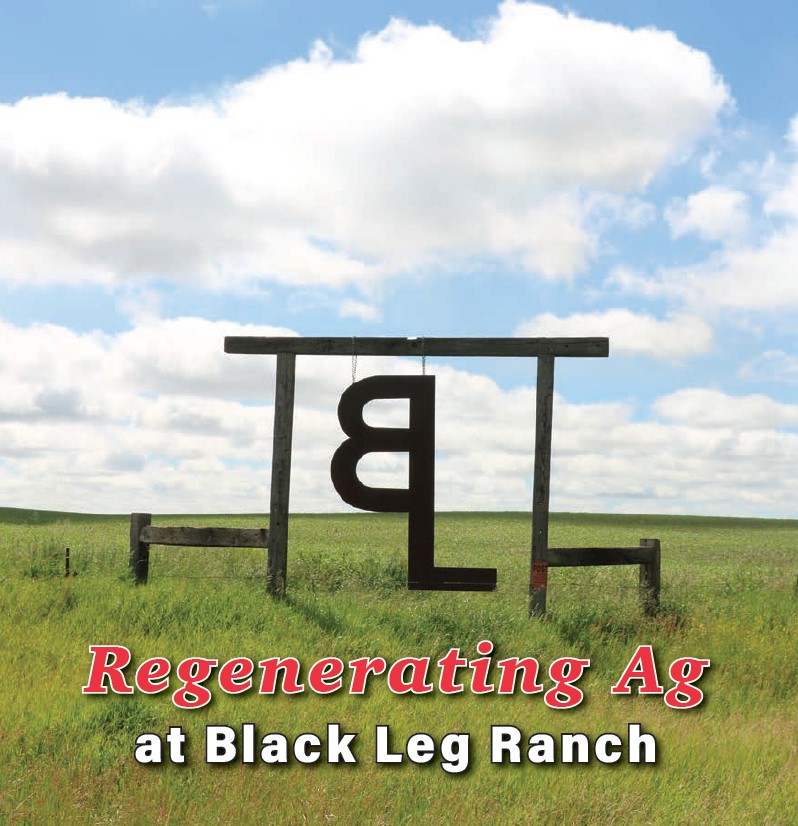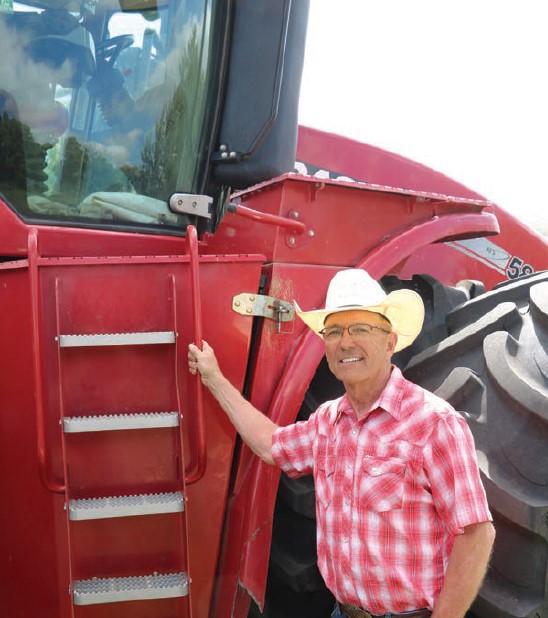News & Events
August 20, 2024
Regenerating Ag at Black Leg Ranch
This article was taken from the August 2024 Soybean Growers Magazine, Volume 13, Issue 4

Jerry Doan’s name is well known in many North Dakota agriculture circles because of his passion for holistic management and the regenerative techniques practiced on his family’s Black Leg Ranch near McKenzie. The ranch has received notable recognition for its conservation efforts, including being named a National Environmental Stewardship Award Winner and being the recipient of North Dakota’s first Leopold Award, which is named after famed conservationist Aldo Leopold.
As the fourth-generation Doan to farm the land southeast of Bismarck, Jerry Doan realized early in his farming career that something in the operation needed to change. Doan returned to the farm in the 1980s when the ag economy was struggling. He saw the farm’s net worth eroding and knew he needed to do something different or risk losing the farm. “I had just gotten out of college, and the guys that I had admired the most, the guys that I thought had it figured out, there’s not one of them farming anymore,” Doan recalls. “That made quite an impact.”
Doan went through Allan Savory’s Holistic Management. Doan describes how the course taught a lot about common sense. “I look back at my grandfather who bought land for a dollar an acre in the Depression era, and people said he was crazy,” Doan says. “He worked two jobs to keep from giving the farm away because he couldn’t afford the tax. A lot of the things I learned in Holistic Management, I think he already knew, because he was an entrepreneur before anybody knew what that was, and he used nature to his benefit.”
Grassland Focus
Doan started using practices to help rebuild the quality of the ranch’s grasslands while also improving the cropland’s soil quality. “It was called sustainable, but I don’t like the term ‘sustainable.’” Doan explains. “Why would I want to sustain something that’s been degraded? We have degraded our natural resources, our soil health and our grasslands.”
Prior to settlement, healthy grasslands included huge roving herds of bison that would move through an area every couple of years. Black Leg Ranch utilizes the planned rotational grazing of its cattle to replicate the effects of the bison herds of old.
“All of a sudden, we have all this plant diversity coming back,” Doan asserts. “It’s high animal impact, short duration, long rest and recovery period, basically the same thing the buffalo did. Now, we’re just having to do it with fencing and management. That’s improved our grassland immensely.”
Doan contends that the healthy grasslands have also helped improve the water quality. Doan states that he had three goals when adopting regenerative ag practices. He wanted to improve soil health, cut winter cattle feeding costs and propagate wildlife. “I’m happy to report that we’ve done all three,” Doan confirms. In addition to rotational grazing cattle, the Doan family plants cover crops on the cropland, utilizing as many as 25 different plants. Planting legumes and brassicas helps to pull nitrates from the soil and to open pores, allowing for water infiltration and supporting diverse soil biology. Once cash crops, including soybeans, are harvested, cattle graze the remaining cover crops. That grazing helps reduce winter feeding costs while also assisting with soil health. “Our water quality is going up because we’re keeping that manure and urine out on those fields, and what that’s doing then is our biology’s finally coming back, and our soil health is improving,” Doan says. “If you compare our soil that we’ve had multiple years in a rotation between cash crops and cover crops, our soil is porous, and the biology is huge. I think we’re just scratching the surface on what we know about what happens under the ground with all the different little creatures.”
Doan describes how, traditionally, tilled soil is often packed and blocky, forcing farmers to increase their inputs of fertilizer and chemicals just to keep the land productive. “What used to be very productive, high producing, healthy soils are going to continue to decline at a drastic rate unless we start to do things a little smarter,” Doan contends.

Diversity is Good
Doan states that he’s not only a proponent of diversity in agriculture, but he’s also an advocate for the value of grasslands. With broad discussions within agriculture about climate-smart practices and carbon sequestration, Doan believes that grasslands are an important part of the conversation. “When I grew up, we always heard about how we’re going to lose the rainforest and how we need to protect them,” Doan recalls. “The grasslands probably do more for the climate than the rainforest, and yet we’re allowing them to be taken away by urban sprawl or conversion to cropland. We need to pay attention to that.”
Doan says that he’s a firm believer in regenerative ag as well as the benefit to farmers, to water quality and to the climate. “We don’t have to get into a fight about whether or not you believe man is causing climate change, but agriculture can be the solution if we just incentivize it and allow it to happen, and we won’t have to spend trillions of dollars to do it,” Doan asserts.
Profitability and Fun
The challenging years of Doan’s farming career not only led to him rethink the way he farmed, but also what the farm encompassed. Difficult economics, along with the loss of his father and a long-time hired hand, had Doan questioning why he would continue farming. “I told my wife I’ve either got to do something different, or I’m going to quit. This isn’t fun anymore,” Doan explains. “Then, I got involved in regenerative ag and saw the progression.”
The progression of Black Leg Ranch has grown to include direct meat sales, agritourism, a hunting and outfitting operation, a brewery and a wedding venue. The diverse operations within the ranch’s umbrella have allowed Doan’s three sons to return to the family business. “Two of our main goals are bringing profitability back and improving our quality of life, and I think it’s the two things that most of agriculture misses,” Doan contends. “We have a tendency to keep doing what we’re doing over and over, and then, we wonder why it doesn’t work. But we can bring profitability back, be smart, build soil health and then protect our legacy for the next generation. That’s a big deal to me, and I see a lot of places not being able to say that.”
Doan frequently speaks to groups about Black Leg Ranch and the regenerative practices that it employs. He’s often asked how to bring the next generation back to the farm. He describes how there has to be a reason for the next generation to come back to the farm. “Kids today have a million opportunities. They are not going to go back to ag operation if it’s all negative,” Doan states. “It’s got to be positive, and you’ve got to allow them to have room to grow. If we’re going to keep farmland in the hands of family agriculture, which I 100% believe in, we better allow it to grow and let people spread their wings a little bit and do things differently. Create some excitement and get out of the way.”
-Story and photos by Daniel Lemke
Click Here to view a copy of the article.
